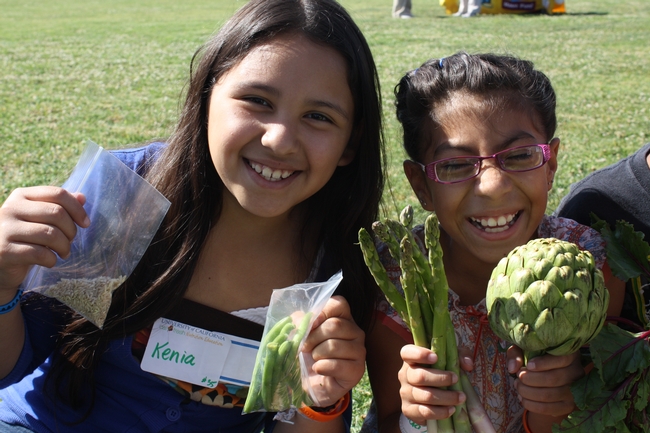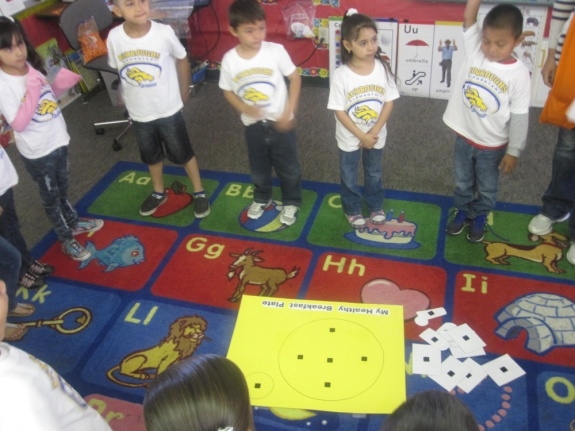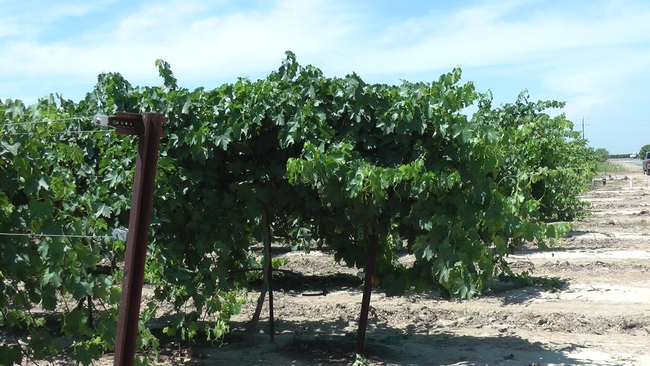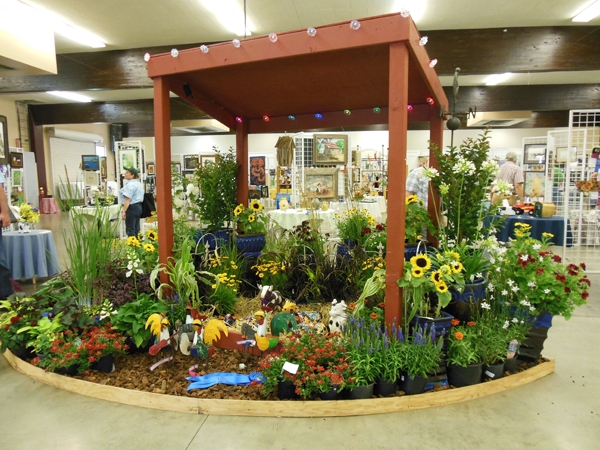UC Food and Agriculture Blogs
Ever explore an artichoke?
Have you ever seen young students explore an artichoke for the first time? Their faces look puzzled as they wonder if this green spiny thing they hold before them is even edible. What about a kiwi? Eyebrows furrow in bewilderment when kids encounter this fuzzy fruit for the first time. Our favorite kiwi quote from a fifth-grade student: “This smells like dirt.”
All jokes aside, in Fresno County, nutrition education is becoming a priority for teachers. The UC CalFresh Nutrition Education Program has worked with over 950 teachers at over 80 schools throughout the county this school year. Our teachers are innovative, and continue to be outstanding in their approach to nutrition education!
While there isn’t enough space to recognize all outstanding educators, we are excited to share a few examples of the ways teachers are going above and beyond to teach students nutrition.
At Ayer Elementary, kindergarten teachers John Schnell, Donna Johnston, Catherine Uribe, and Nancy Patrick have made healthy eating and active living a priority. They actively take part in nutrition education and monthly tastings provided by UC Calfresh. They often bring in additional healthy foods for the students to sample. Understanding the importance of nutrition in a family-setting, Ayer teachers have invited UC CalFresh to partner in providing kinder parents important nutrition tips to get the year off to a healthy start.
Following a lesson taught by a UC CalFresh program coordinator at Balderas Elementary, Mrs. Nunez’s third-grade class created a collage of “Sometime vs. Anytime” foods. Mrs. Nunez went the extra step to reinforce the key concept of enjoying foods in moderation. Students took the information learned and made “anytime meals.” Students’ artwork was displayed in the hallway for all to see.
“We put our milk in, we take the milk out…and we shake it all about."
It's breakfast time at Burroughs Elementary. Mrs. Mata-Webb’s kindergarten class learned the importance of breakfast through song and dance. Students practiced building a healthy breakfast by including three of the five food groups at breakfast time.
Dedicated to ensuring the health of our students, food service staff in Fresno Unified have also gone the extra mile to help promote our adult nutrition education classes and workshops.
The educators and school staff spotlighted provide a glimpse of the endless examples of excellent nutrition education happening in Fresno County. Statewide, the UC CalFresh Nutrition Education Program is very fortunate to work with such amazing educators. At the University of California Cooperative Extension, we’re working through schools to teach kids good food habits and decision-making skills.
If you would like to have the UC CalFresh Nutrition Education Program at your school contact Shelby MacNab, (559) 600-7222 or smacnab@ucdavis.edu. For additional information, visit our website.
Have a happy, healthy July 4 celebration
For as long as I can remember, Independence Day has not been about being alone and independent, the Fourth of July is traditionally spent with family and friends, barbecuing, overeating and watching fireworks. Come to think of it, aren’t all American holidays celebrated with abundant quantities of food? And those mass quantities of food tend to be set out on July 4 and left within easy reach for hours.
It’s a wonder July 5th isn’t national foodborne illness day. According to UC food safety experts, food left at room temperature for two hours can become unsafe to eat. If left out in summer heat above 90 degrees, bacteria get busy and can grow to unsafe levels in food in one hour.
UC Cooperative Extension has a handout online called “The Lunch Box,” which contains tips for making school lunches that don’t deliver foodborne illness. A lot of those tips apply to picnics as well, such as “Keep hot things hot and cold things cold.”
The main foods The Lunch Box recommends be kept cold (40 degrees F or lower) are meat, poultry, fish, eggs, milk, soft cheese and pasta salad, which usually contains mayo. Peeled or cut fruits and vegetables should also be kept cold to deter bacteria growth. Chili, casseroles and refried or baked beans should either be piping hot or chilled. Foodsafety.gov has details for properly preparing, serving and storing various foods.
Brenda Roche Wolford, UC Cooperative Extension advisor in Los Angeles County, specializes in nutrition, family and consumer sciences and pointed me to the Partnership for Food Safety Education website. The partnership recommends four food handling steps to prevent you and your family from suffering foodborne illness and Brenda adds a fifth step:
- Clean
- Cook
- Separate
- Chill
Bonus step: Throw it away
Yes, we must be told explicitly to throw away contaminated food. Most Americans have been told since childhood that we shouldn’t waste food because children in a country that we haven’t visited are starving. I feel the guilt too. Yet, I’d rather chuck suspect food than to be upchucking it later. Those are my words, not Brenda’s. She uses much more professional terms like nausea.
UC ANR has created the “Make it Safe, Keep it Safe” training for employees and volunteers, but it has useful information that anyone can use. The U.S. Food and Drug Administration also has tips for handling food safely when eating outdoors, such as “don’t cross-contaminate.” See the UC Food Safety website for all kinds of food safety information, including publications in Spanish. And if you need some tunes for your party, visit the UC Food Safety Music website to hear “Don’t Get Sicky Wit It,” “Stomachache Tonight,” “We are the Microbes” and many more.
May you have a happy and healthy Independence Day!
Kitchen table memories
Not long ago, a friend asked several of us to jot down some memories about the kitchen tables in our lives. The operating premise of the exercise was that food is central to our relationships, and that much of life occurs around the places where we eat, and those we choose to eat with.
My kitchen table memories are varied. My family moved quite frequently when I was young: our kitchen table was a sort of “movable feast.” In my faith tradition, this term has a very specific meaning that informs my attitudes toward food. (For the very literary minded, it is also the title of a wonderful memoir written by Ernest Hemingway late in his life).
I have wonderful memories about kitchen tables. In our home near Philadelphia, I remember my older sister sitting at the table in the spacious kitchen, trying to cajole me to eat more before we went to church. I was served the best pancakes I’ve ever eaten at that very table. It was at this table where my brother once committed the serious transgression of launching scrambled eggs at my sister, using his fork as the springboard. (This happened exactly once.) A few years later, in the San Fernando Valley, close by some citrus orchards where the California State University campus now stands, I recall eating wonderful meals at our new home, which featured a formal dining room, where my parents proudly used the plastic fruit I’d bought them as a gift as the table’s centerpiece.
I remember my Grandmother Eloise’s elegantly appointed dining room table in Clinton, Miss., where we always drank heavily sugared iced tea from the tallest glasses I'd ever seen, being certain to clink the ice with long handled silver spoons. My grandmother’s was the most modern kitchen I’d ever seen, and she dressed up for every meal. Only a few miles away, in Jackson, we also took supper with my other grandparents, RJ and Pauline, at their kitchen table in a modest home on a quiet tree-lined street. These grandparents, raised in a small rural community, fed us homegrown sliced tomatoes, stewed okra, skillet cornbread, fish caught by my grandfather, and bowls of steaming hot (and spicy!) gumbo.
I also remember the dinette set in my family’s small camping trailer, where my dad prepared and fed his kids Kraft Mac & Cheese and tuna fish. (Different food generation, but great dad!) It was also the table where we played board games and cards by lantern light, watching the Firefall at Yosemite Park. After dinner, games and a soothing cup of hot chocolate, the dinette set was folded down and became the bed I slept on.
When my husband and I got our first apartment, we went to a used furniture store called Egypt's and bought a tiny bowed kitchen table. It was constructed of particleboard and covered with faux wood laminate. We used it for years. It was where we prepared our budget-wise home cooked meals every night, clipped coupons and prepared for graduate exams.
When we bought our home, we found ourselves with more space, but little cash to furnish it. While visiting a second-hand store in our tiny downtown, we fell in love with a large, heavy table. It was a little dinged up, was missing the leaves, but clearly had been loved by a large family. It featured an extra set of legs in the middle of the table, meant to support it at its grand length when fully extended. We paid what was for us a small fortune to purchase the table, and got friends to help us move it. We had no chairs, so a friend gave us three turn-of-the-(last)-century chairs salvaged from the U.S. Maritime Commission Office in Long Beach. They don't match the table or each other, but we've never cared and have kept them. They are simply marvelous.
We live in a small home, so our table serves as both kitchen and dining room table, just a foot or so from the counter and the stove. While a smaller table might make more sense, I'd never let this one go. We refinished it several years ago, and it turns out that it's quite an unusual and valuable table, worth many, many times what we paid for it.
It's certainly priceless to me, mostly because it's anchored our family in this house. As the child of movable tables and movable feasts, I've found its constant presence uniquely reassuring. It's where we prepare food and school projects and where I do much of my writing. It's where I sat my daughter and bandaged her first skinned knee. It’s where the three of us share breakfast together every morning. Where we’ve hosted birthday and holiday celebrations, team parties, teen gatherings, study groups and committee meetings (all involving good food and good people). Where we’ve had important family discussions, shared memories, and laughed. It's where my husband reads the sports page, where I fume over the editorial page, and where my daughter and I craft and sew. It's sited between two windows three feet from our side fence, where honeysuckle grows lush and fragrant, and where the poinsettia transplanted from our neighbor’s yard more than 20 years ago blooms brightly.
The kitchen table hosts ever-changing coverings. A tablecloth given to us by friends after their trip to Guatemala. Another one made by my sister, with matching napkins. An antique lace cloth I found in a small store near home. On very special occasions, we let the wood speak for itself.
I don't know the history of the table before it joined our family, but it has claimed a central place in our family's history. After we purchased this table, the table we purchased from Egypt’s was recycled to hold an ever-growing collection of plants. It finally expired a few years ago. I was sad to see it go.
Have a safe and happy summer, filled with healthy and delicious food, eaten at tables you love, with those you cherish.
Vintner creates interesting new wines from research grapes
Nearly half of the 55 unusual winegrape varieties in a plot at the UC Kearney Agricultural Research and Extension Center in Parlier displayed enough promising characteristics to prompt a cooperating vintner to make 25 small lots of wine.
The research at Kearney is designed to expand the wine industry’s options in the San Joaquin Valley, currently California’s top grape growing district in terms of production, but lowest in terms of price.
“Most of the popular wine varietals – Merlot, Cabernet Sauvignon, Chardonnay – are at their best in somewhat cooler climates. So we are looking for grapes that make superior fruit in warm climates,” said Matthew Fidelibus, UC Cooperative Extension specialist in the Department of Viticulture and Enology at UC Davis.
Fidelibus is supervising the production at Kearney of winegrape varieties that were collected from countries such as Spain, Greece and Italy, where the climate mimics the valley’s hot days and warm evenings. In the research plot, the vines exhibit a wide range of vigor, productivity and fruit quality.
While Fidelibus is gathering data on each variety’s yield potential, cluster architecture, amenability to mechanization and other viticultural characteristics, winemaker Constellation Brands is monitoring the winegrapes’ potential to produce distinctive, flavorful California wines.
“We need a breakthrough variety,” said Oren Kaye, a research and development winemaker at Constellation Brands. “Many of the wines we produced showed significant promise.”
Currently, 80 percent of California wine is made from fewer than 10 types of winegrapes, with the most popular white being Chardonnay and the most popular red Cabernet Sauvignon.
Kaye says the market is ripe for something new, perhaps Fianio, a white wine with a fresh, young style evoking flavors of melon and grapefruit, or the stylistically unique Marselan Noir, a red wine with bright cherry flavor that pops.
“Millennials own tomorrow,” Kaye said. “They are more accepting of things that are new, as long as it is good. At a restaurant, they think nothing of pulling out a smart phone to look up a wine they haven’t heard of before.”
Fidelibus comments in the video below about a recent tasting event that featured four winegrape varieties from the Kearney trial:
New wine varietals
Fairground farms & farmyard festivals
Do county fairs make you think of deep-fried Twinkies and Ferris wheels, and maybe some prize-winning pigs? Can you imagine a local food marketplace next to the quilt show, a demonstration farm by the pony rides, fresh fruit for sale in the midway, a community dinner honoring local farmers, and housing available for hundreds of farm-workers the week after the fair closes?
These all thrive at some of California's county and district fairs, and may be part of the future at many others soon. The University of California small farm program and the California Department of Food and Agriculture (CDFA) Division of Fairs and Expositions are teaming up to connect fruit, vegetable, nut and flower farmers with county and regional fairs to celebrate California specialty crops and encourage agritourism. Fair organizers also hope to develop new partnerships that help support the fairs - particularly important now as the fairs have recently lost funding due to state budget cuts.
“We look forward to working with CDFA’s Division of Fairs and Expositions to expand agritourism opportunities; this will expand revenue sources for California’s small farmers,” said Shermain Hardesty, UC Cooperative Extension specialist in the UC Davis Department of Agricultural and Resource Economics. Hardesty leads the UC small farm program.
Together we are organizing workshops and tours for farmers and agricultural leaders at seven different fairs throughout the state, to be held during fair time in the 2012 fair season. We're calling the project "Fairground Farms and Farmyard Festivals; Showcasing California Specialty Crops."
Each workshop will be a little different, because each of the fairs has it's own unique history and community. We'll hear fair officials sharing with farmers some of their methods for safely entertaining and feeding thousands of people. We'll have presentations by farmers currently involved with local fairs or local agritourism, interactive discussions on potential collaborations between specialty crop growers, agritourism operators and fairs, and guided tours of the fair facilities.
At the first workshop, held at the Shasta District Fair in Anderson on June 14, fair leaders from several Northern California fairs listened to Tehama County Farm Bureau leader Kari Dodd explain how she had helped set up the marketplace for local growers at the Tehama County Fair. Then they discussed how to set such a program up at their own fairs. Other ideas raised by the group included demonstration farms and gardens, greenhouses, year-round restaurants and rental kitchens at the fair grounds, and local food events.
The next workshop and tour will be Thursday July 26 at the Amador County Fair in Plymouth, hosted by Fair CEO Troy Bowers. At this event we will hear from Mountain Mandarin Festival organizer and cookbook author Joanne Neft, as well as from representatives of Farms of Amador, Amador County Grape Growers, and MotherLode Harvest, who all participate in the Amador Fair. Following Amador, we visit Ventura, Napa, Yolo, Santa Cruz and Fresno.
Registration for all of the workshops is now open. We welcome farmers and fair leaders from surrounding counties to each fair workshop, as well as county agricultural commissioners, Farm Bureau leaders, tourism professionals, farm advisors and educators, fair and festival vendors and entertainers and agritourism operators interested in new partnerships.
Let's talk!
The workshop schedule:
Thursday, July 26 - Amador County Fair, Plymouth
Thursday, August 2 - Ventura County Fair, Ventura
Thursday, August 9 - Napa Town & Country Fair, Napa
Thursday, August 16 - Yolo County Fair, Woodland
Thursday, September 13 - Santa Cruz County Fair, Watsonville
Thursday, October 4 - Big Fresno Fair, Fresno
For registration and more information about the events is online or call Penny Leff at (530) 752-7779
See you at the fair!













